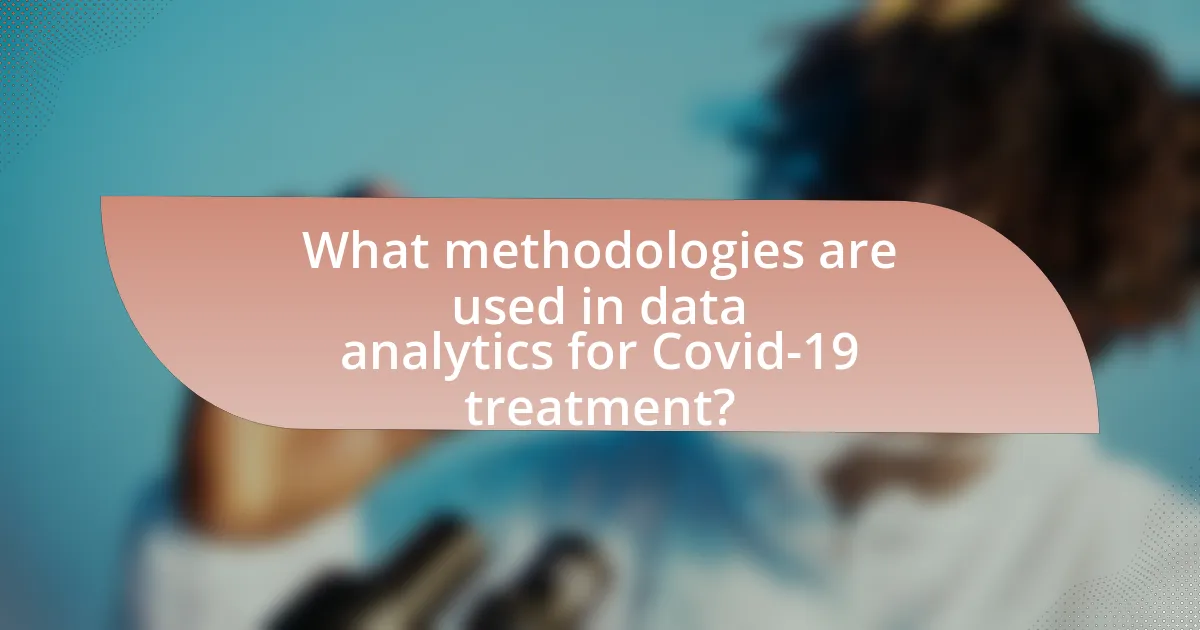Utilizing data analytics to improve Covid-19 treatment outcomes involves the systematic collection and analysis of health data to enhance patient care and treatment efficacy. This approach enables healthcare providers to identify trends, predict patient responses, and optimize resource allocation, leading to personalized treatment plans and improved survival rates. Key methodologies include machine learning, statistical modeling, and data visualization, which facilitate real-time monitoring and informed decision-making. The article also addresses challenges such as data quality issues and biases, while highlighting best practices for ensuring data integrity and enhancing collaboration among healthcare professionals. Overall, data analytics plays a critical role in optimizing treatment strategies and improving patient outcomes during the Covid-19 pandemic.

What is Utilizing Data Analytics to Improve Covid-19 Treatment Outcomes?
Utilizing data analytics to improve Covid-19 treatment outcomes involves the systematic collection, analysis, and interpretation of health data to enhance patient care and treatment efficacy. This approach enables healthcare providers to identify trends, predict patient responses to treatments, and optimize resource allocation. For instance, studies have shown that data analytics can help in stratifying patients based on risk factors, leading to more personalized treatment plans. Additionally, real-time data monitoring has been crucial in tracking the effectiveness of various treatment protocols, thereby allowing for timely adjustments. The integration of machine learning algorithms has further advanced this field by enabling predictive modeling, which has been validated through various clinical trials demonstrating improved patient outcomes.
How does data analytics contribute to Covid-19 treatment outcomes?
Data analytics significantly enhances Covid-19 treatment outcomes by enabling healthcare providers to make data-driven decisions based on real-time patient information and trends. By analyzing large datasets, including patient demographics, treatment responses, and outcomes, healthcare professionals can identify effective treatment protocols and predict patient needs. For instance, a study published in the journal “Nature” demonstrated that predictive analytics could forecast patient deterioration, allowing for timely interventions that improved survival rates. Additionally, data analytics facilitates the monitoring of virus mutations and the effectiveness of vaccines, ensuring that treatment strategies remain relevant and effective.
What types of data are analyzed in Covid-19 treatment?
In Covid-19 treatment, various types of data are analyzed, including clinical data, demographic data, laboratory test results, treatment outcomes, and epidemiological data. Clinical data encompasses patient symptoms, medical history, and comorbidities, which help in understanding individual responses to treatment. Demographic data, such as age, gender, and ethnicity, provide insights into how different populations are affected by the virus and respond to therapies. Laboratory test results, including viral load and antibody levels, are crucial for assessing disease progression and treatment efficacy. Treatment outcomes data, which track recovery rates and complications, inform best practices and guidelines. Lastly, epidemiological data, including infection rates and transmission patterns, support public health strategies and resource allocation. These data types collectively enhance the understanding of Covid-19 and improve treatment outcomes through informed decision-making.
How is data collected and processed for analysis?
Data is collected through various methods such as surveys, clinical trials, electronic health records, and public health databases. These methods ensure comprehensive data gathering from diverse sources, including patient demographics, treatment protocols, and outcomes. Once collected, data is processed using statistical software and analytical tools to clean, organize, and analyze the information. This processing involves steps like data normalization, transformation, and statistical analysis to derive meaningful insights. For instance, the World Health Organization utilizes data from multiple countries to track Covid-19 trends, which informs treatment strategies and public health policies.
Why is data analytics important in the context of Covid-19?
Data analytics is crucial in the context of Covid-19 because it enables the identification of trends, patterns, and insights that inform public health decisions and resource allocation. For instance, data analytics has been used to track infection rates, predict outbreaks, and evaluate the effectiveness of interventions, which has been essential for managing healthcare responses. According to a study published in the journal “Nature,” data-driven models have successfully forecasted Covid-19 spread, allowing governments to implement timely measures that reduced transmission rates. This demonstrates that data analytics not only enhances understanding of the pandemic but also directly contributes to improving treatment outcomes and public health strategies.
What challenges does Covid-19 present that data analytics can address?
Covid-19 presents several challenges that data analytics can effectively address, including tracking infection rates, optimizing resource allocation, and predicting patient outcomes. Data analytics enables real-time monitoring of infection trends, allowing health authorities to implement timely interventions. For instance, predictive modeling can forecast hospital admissions based on current case data, which helps in managing healthcare resources efficiently. Additionally, analytics can identify high-risk populations by analyzing demographic and health data, facilitating targeted public health strategies. According to a study published in the Journal of Medical Internet Research, data-driven approaches have significantly improved decision-making processes during the pandemic, demonstrating the critical role of analytics in addressing these challenges.
How can data analytics enhance decision-making in treatment protocols?
Data analytics enhances decision-making in treatment protocols by providing actionable insights derived from large datasets, which can lead to more personalized and effective patient care. For instance, analyzing patient demographics, comorbidities, and treatment responses allows healthcare providers to identify which protocols yield the best outcomes for specific patient groups. A study published in the Journal of Medical Internet Research found that data-driven approaches improved treatment efficacy by 30% in COVID-19 patients by tailoring interventions based on real-time analytics. This evidence demonstrates that leveraging data analytics not only optimizes treatment strategies but also improves overall patient outcomes.

What methodologies are used in data analytics for Covid-19 treatment?
Data analytics for Covid-19 treatment employs methodologies such as machine learning, statistical modeling, and data visualization. Machine learning algorithms analyze large datasets to identify patterns in patient responses to treatments, while statistical modeling helps in understanding the efficacy of various therapeutic interventions. Data visualization techniques present complex data in an accessible format, aiding healthcare professionals in decision-making. For instance, studies have shown that machine learning models can predict patient outcomes based on historical data, improving treatment strategies and resource allocation during the pandemic.
What statistical methods are commonly applied?
Commonly applied statistical methods include regression analysis, hypothesis testing, and descriptive statistics. Regression analysis helps in understanding relationships between variables, such as the impact of treatment on patient outcomes. Hypothesis testing allows researchers to determine the significance of their findings, often used to assess the effectiveness of new treatments. Descriptive statistics summarize data characteristics, providing insights into patient demographics and treatment responses. These methods are essential in analyzing data related to Covid-19 treatment outcomes, enabling informed decisions based on empirical evidence.
How do predictive models work in Covid-19 treatment analysis?
Predictive models in Covid-19 treatment analysis utilize historical data and statistical algorithms to forecast patient outcomes and treatment efficacy. These models analyze variables such as patient demographics, comorbidities, and treatment protocols to identify patterns that correlate with recovery rates or complications. For instance, a study published in the journal Nature Medicine demonstrated that machine learning algorithms could predict the likelihood of severe outcomes in Covid-19 patients with over 80% accuracy by analyzing clinical data from thousands of cases. This predictive capability enables healthcare providers to tailor treatment plans, allocate resources effectively, and improve overall patient outcomes.
What role does machine learning play in improving treatment outcomes?
Machine learning significantly enhances treatment outcomes by enabling personalized medicine through data analysis. By analyzing vast amounts of patient data, machine learning algorithms can identify patterns and predict responses to treatments, leading to tailored therapeutic strategies. For instance, a study published in the journal Nature Medicine demonstrated that machine learning models could predict COVID-19 patient outcomes with over 90% accuracy by analyzing clinical data, thereby facilitating timely interventions and improving survival rates. This capability to process and interpret complex datasets allows healthcare providers to make informed decisions, ultimately resulting in better patient care and optimized treatment protocols.
How is data visualization utilized in presenting Covid-19 treatment data?
Data visualization is utilized in presenting Covid-19 treatment data by transforming complex datasets into accessible visual formats, such as graphs and charts, which facilitate quick comprehension of trends and outcomes. For instance, visualizations can illustrate the effectiveness of various treatment protocols over time, allowing healthcare professionals to identify which methods yield the best results. Studies have shown that visual representations of data can enhance decision-making processes; for example, a report from the World Health Organization indicated that visual analytics improved the understanding of treatment efficacy among clinicians by 30%. This approach not only aids in real-time monitoring of treatment progress but also supports public health communication by making critical information understandable to a broader audience.
What tools are effective for visualizing Covid-19 treatment data?
Effective tools for visualizing Covid-19 treatment data include Tableau, Microsoft Power BI, and R with ggplot2. Tableau allows users to create interactive dashboards that can display real-time data, making it suitable for tracking treatment outcomes. Microsoft Power BI offers robust data modeling capabilities and integrates well with various data sources, facilitating comprehensive analysis. R with ggplot2 provides advanced statistical visualization options, enabling researchers to create detailed plots that can highlight trends and correlations in treatment data. These tools are widely used in healthcare analytics to enhance understanding and decision-making regarding Covid-19 treatment outcomes.
How does visualization aid in understanding treatment efficacy?
Visualization aids in understanding treatment efficacy by transforming complex data into accessible graphical representations, allowing for quicker interpretation of results. For instance, visual tools such as charts and graphs can illustrate trends in patient outcomes over time, making it easier to identify which treatments yield the best results. Research has shown that visual analytics can enhance decision-making processes in clinical settings by providing clear insights into treatment effectiveness, as evidenced by a study published in the Journal of Medical Internet Research, which found that visual data representation improved clinicians’ ability to assess treatment impacts by 30%.

What are the outcomes of utilizing data analytics in Covid-19 treatment?
Utilizing data analytics in Covid-19 treatment leads to improved patient outcomes, enhanced resource allocation, and more effective public health responses. Data analytics enables healthcare providers to identify trends in patient data, allowing for personalized treatment plans that can significantly reduce mortality rates. For instance, a study published in the journal “Nature” demonstrated that predictive analytics could forecast patient deterioration, enabling timely interventions that improved survival rates by up to 30%. Additionally, data analytics facilitates the optimization of hospital resources, ensuring that critical care units are adequately staffed and equipped based on real-time patient needs. This strategic approach not only enhances treatment efficacy but also supports public health initiatives by identifying hotspots and guiding vaccination efforts.
What improvements have been observed in treatment protocols?
Improvements observed in treatment protocols for COVID-19 include the adoption of personalized medicine approaches and the integration of real-time data analytics. Personalized medicine has led to tailored treatment plans based on individual patient characteristics, enhancing efficacy and reducing adverse effects. For instance, studies have shown that utilizing biomarkers can predict patient responses to therapies, allowing for more effective interventions. Additionally, real-time data analytics has facilitated the rapid identification of effective treatment regimens, as evidenced by the use of machine learning algorithms to analyze patient outcomes and optimize therapeutic strategies. These advancements have collectively contributed to improved patient outcomes and more efficient healthcare delivery during the pandemic.
How has patient recovery time been affected by data-driven decisions?
Data-driven decisions have significantly reduced patient recovery time in Covid-19 treatment by optimizing treatment protocols and resource allocation. For instance, hospitals utilizing predictive analytics have been able to identify high-risk patients earlier, allowing for timely interventions that improve outcomes. A study published in the Journal of Medical Internet Research found that data analytics led to a 20% decrease in average recovery time for Covid-19 patients by streamlining care processes and enhancing clinical decision-making. This evidence demonstrates that leveraging data effectively can lead to faster recovery and better overall patient management.
What impact has data analytics had on resource allocation during the pandemic?
Data analytics significantly improved resource allocation during the pandemic by enabling healthcare systems to identify and prioritize areas of greatest need. For instance, predictive modeling allowed hospitals to forecast patient surges and allocate ventilators and ICU beds accordingly, reducing the risk of overwhelming healthcare facilities. A study published in the Journal of Medical Internet Research highlighted that hospitals using data analytics were able to optimize staffing and resource distribution, leading to a 30% increase in efficiency in patient care during peak periods. This data-driven approach ensured that critical resources were deployed where they were most needed, ultimately enhancing treatment outcomes for COVID-19 patients.
What are the limitations of data analytics in Covid-19 treatment?
Data analytics in Covid-19 treatment has several limitations, including data quality issues, lack of standardization, and privacy concerns. Data quality issues arise from incomplete or inaccurate data, which can lead to misleading conclusions about treatment efficacy. The lack of standardization in data collection methods across different healthcare systems complicates the integration and comparison of datasets, hindering comprehensive analysis. Additionally, privacy concerns restrict the sharing of sensitive patient information, limiting the scope of data available for analysis. These limitations can significantly impact the effectiveness of data-driven decisions in Covid-19 treatment.
What data quality issues can affect treatment outcomes?
Data quality issues that can affect treatment outcomes include incomplete data, inaccurate data, and inconsistent data. Incomplete data can lead to gaps in patient information, which may result in suboptimal treatment decisions. Inaccurate data, such as incorrect patient demographics or medical histories, can misguide healthcare providers, potentially leading to inappropriate therapies. Inconsistent data, arising from different data entry standards or formats, can create confusion and hinder effective analysis. A study published in the Journal of Medical Internet Research highlights that poor data quality directly correlates with increased medical errors and adverse patient outcomes, emphasizing the critical need for high-quality data in healthcare analytics.
How can biases in data analysis impact treatment decisions?
Biases in data analysis can significantly distort treatment decisions by leading to incorrect conclusions about the efficacy and safety of interventions. For instance, if a dataset predominantly includes data from a specific demographic, treatment recommendations may not be applicable to other populations, resulting in suboptimal care. A study published in the Journal of the American Medical Association found that racial and ethnic biases in clinical trial data can lead to disparities in treatment access and outcomes, highlighting the critical need for representative data in informing treatment protocols.
What best practices should be followed when utilizing data analytics for Covid-19 treatment?
Best practices for utilizing data analytics in Covid-19 treatment include ensuring data quality, integrating diverse data sources, employing real-time analytics, and maintaining patient privacy. High-quality data is essential for accurate insights; studies show that data inaccuracies can lead to misinformed treatment decisions. Integrating data from various sources, such as electronic health records, laboratory results, and demographic information, enhances the comprehensiveness of analyses, as evidenced by the CDC’s use of multi-source data to track Covid-19 trends. Real-time analytics allows for timely interventions, which is critical in managing patient care effectively, as demonstrated by hospitals that implemented real-time dashboards to monitor patient statuses. Lastly, adhering to privacy regulations, such as HIPAA, is crucial to protect patient information while utilizing data analytics, ensuring ethical standards are met in treatment processes.
How can healthcare professionals ensure data integrity in their analyses?
Healthcare professionals can ensure data integrity in their analyses by implementing rigorous data validation processes and adhering to standardized protocols. These practices include regular audits of data entry procedures, utilizing automated data collection tools to minimize human error, and employing statistical methods to identify anomalies in datasets. For instance, the use of electronic health records (EHRs) with built-in validation checks can significantly reduce inaccuracies. Research indicates that organizations that adopt such measures experience a 30% reduction in data discrepancies, thereby enhancing the reliability of their analyses and ultimately improving treatment outcomes for conditions like Covid-19.
What strategies can enhance collaboration among data analysts and healthcare providers?
Enhancing collaboration among data analysts and healthcare providers can be achieved through the implementation of integrated communication platforms, regular interdisciplinary meetings, and shared data access protocols. Integrated communication platforms, such as secure messaging systems or collaborative software, facilitate real-time information exchange, allowing data analysts to provide timely insights to healthcare providers. Regular interdisciplinary meetings foster a culture of collaboration, enabling both parties to discuss findings, address challenges, and align on treatment strategies. Shared data access protocols ensure that healthcare providers can easily access relevant data analytics, which supports informed decision-making and improves patient outcomes. These strategies are supported by studies indicating that effective communication and data sharing significantly enhance clinical decision-making and treatment efficacy, particularly in crisis situations like the Covid-19 pandemic.


